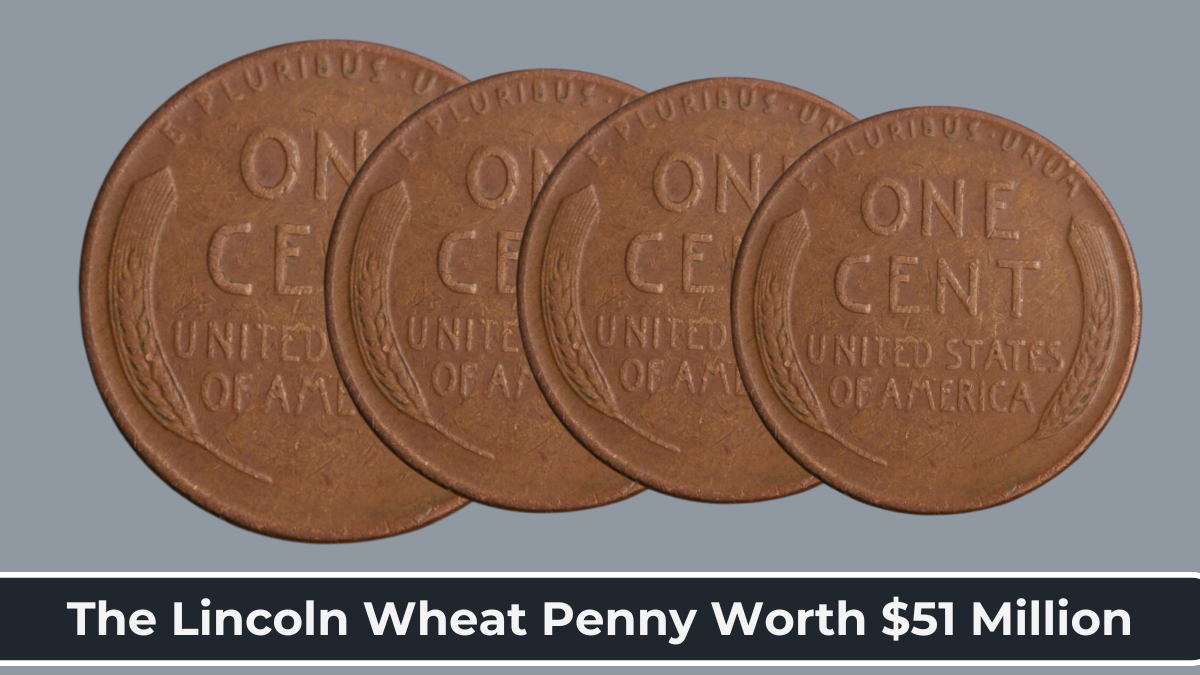In the world of rare coin collecting, few stories capture the imagination quite like that of the 1943 Copper Lincoln Wheat Penny. Valued at an astounding $51 million, this single coin represents more than just a collector’s dream—it’s a piece of American history shaped by wartime circumstances, a minting error, and extreme rarity.
The Legacy of the Lincoln Wheat Penny
The Lincoln Wheat Penny was first minted in 1909 to commemorate the 100th anniversary of Abraham Lincoln’s birth. Designed by Victor David Brenner, this coin made history as the first U.S. coin to feature a real person rather than the traditional Lady Liberty or Native American imagery.
- Obverse (Front): A portrait of Abraham Lincoln, symbolizing leadership and national unity.
- Reverse (Back): Two wheat stalks surrounding “ONE CENT” and “UNITED STATES OF AMERICA”, representing America’s agricultural prosperity.
This design remained in use until 1958, when it was replaced by the Lincoln Memorial Penny.
The 1943 Copper Penny: A $51 Million Mistake
During World War II, copper was a strategic wartime resource, essential for manufacturing ammunition and military equipment. To conserve copper, the U.S. Mint switched to zinc-coated steel for pennies in 1943. These steel pennies had a silvery appearance and were the only official pennies produced that year.
However, a small number of copper planchets (coin blanks) from 1942 were accidentally struck with the 1943 date, creating one of the rarest and most valuable coins in U.S. history—the 1943 Copper Lincoln Wheat Penny.
Why Is the 1943 Copper Penny Worth $51 Million?
The staggering value of this coin is due to several factors:
Extremely Rare – Fewer than 15 to 20 genuine 1943 Copper Pennies are known to exist.
Wartime Minting Error – These pennies were never supposed to exist, making them a one-of-a-kind numismatic treasure.
Historical Significance – Minted during World War II, it represents a unique moment in U.S. economic and military history.
Collector Demand – The mystery of how many still exist fuels collector interest and skyrockets its value.
The 2015 Discovery: A $51 Million Penny
In 2015, a Philadelphia-minted 1943 Copper Penny was found in pristine condition, sending shockwaves through the numismatic community. Due to its flawless preservation and unique status as one of the finest examples, experts estimated its value at a record-breaking $51 million.
This discovery sparked renewed excitement among collectors, as it raised the possibility that more 1943 Copper Pennies could still be undiscovered.
How to Identify a 1943 Copper Penny
Since counterfeit 1943 Copper Pennies are common, knowing how to identify a real one is crucial. Many fakes are copper-plated steel pennies or altered 1948 coins.
How to Check If You Have a Real One:
Magnet Test – A genuine 1943 Copper Penny will NOT stick to a magnet. Steel pennies will.
Weight Test – A copper penny weighs 3.11 grams, while a steel penny weighs 2.7 grams.
Mint Mark Check –
- A Philadelphia (no mint mark) 1943 Copper Penny is the rarest.
- Denver (D mint mark) and San Francisco (S mint mark) versions are also valuable.
Authentication – The only way to 100% confirm its authenticity is to have it professionally graded by PCGS (Professional Coin Grading Service) or NGC (Numismatic Guaranty Company).
Other High-Value Lincoln Wheat Pennies
While the $51 million penny is the most valuable, several other Lincoln Wheat Pennies are worth thousands—or even millions—of dollars.
| Coin | Estimated Value | Notable Feature |
|---|---|---|
| 1909-S VDB | Up to $100,000 | First Lincoln cent with designer’s initials. |
| 1914-D | Up to $150,000 | Rare Denver Mint production. |
| 1922 “No D” | Up to $90,000 | Denver Mint error—missing mint mark. |
| 1943 Copper Penny | Up to $1.7 million | Mistakenly struck in copper instead of steel. |
| 1955 Doubled Die | Up to $125,000 | Double-struck design creates a unique effect. |
Could a $51 Million Penny Still Be in Circulation?
Shockingly, some 1943 Copper Pennies have been found in everyday transactions, and one missing example may still be out there.
It could be in an old jar of pennies.
It could be hidden in a forgotten collection.
It could still be sitting in circulation, unnoticed.
This keeps collectors searching, turning a simple habit like checking your pocket change into a potential life-changing discovery.
How to Preserve and Sell a Valuable Penny
If you think you’ve found a rare Lincoln Wheat Penny, follow these steps:
- DO NOT clean the coin – Cleaning damages the surface and lowers its value.
- Handle with care – Always hold by the edges to prevent fingerprints and contamination.
- Store in a protective case – Use a certified coin holder to prevent damage.
- Get it professionally graded – Authentication by PCGS or NGC ensures maximum value.
- Sell through reputable dealers – Auction houses like Heritage Auctions or numismatic marketplaces provide secure, high-value transactions.
The Legacy of the Lincoln Wheat Penny
Beyond its monetary worth, the Lincoln Wheat Penny is a piece of history. It tells the story of:
- Wartime resource conservation
- Minting errors that created multimillion-dollar rarities
- The evolution of American coinage
For collectors and historians alike, these pennies are more than just coins—they are symbols of American heritage.
So, before you dismiss your spare change, take a moment to check your pennies—you might be holding a $51 million treasure!
FAQs
Only about 15 to 20 genuine 1943 Copper Pennies are known today.
A real 1943 Copper Penny does NOT stick to a magnet and weighs 3.11 grams.
Sell through auction houses, coin dealers, or numismatic marketplaces like Heritage Auctions.
A 1943 Copper Penny sold for $1.7 million, but the 2015 discovery is valued at $51 million.
Yes! A missing 1943 Copper Penny could still be in circulation today.

